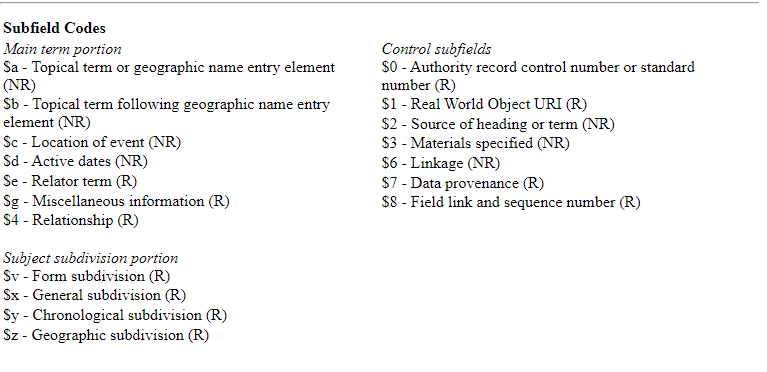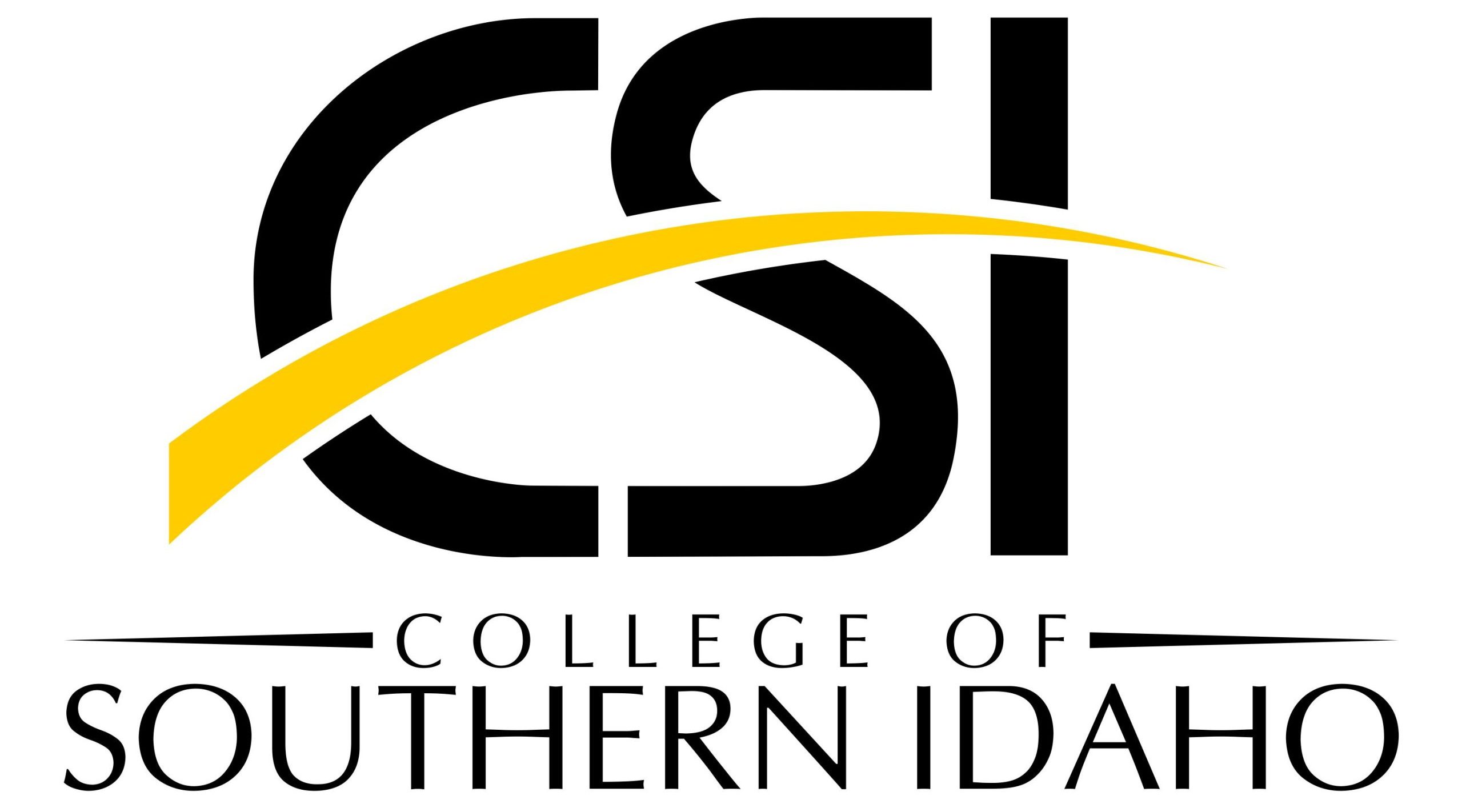13 Library of Congress Authorities: Subject Headings and Names
Some metadata can be recorded in a variety of ways. For example, a summary does not have to include certain keywords in order for it to be valid. Additionally, a title does not have to have a certain number of characters to be considered authoritative. Other metadata, however, is standardized to avoid confusion. The general cataloging term for these specific fields of metadata is called controlled vocabulary, as you may remember.
The 600 fields that deal with people, works, places, and subjects have a special type of controlled vocabulary called an access point. These fields contain information that could be recorded hundreds of different ways. For example, the term for fiction related to scientific fields could be written “Science fiction,” “Science Fiction,” “science fiction,” “sci-fi”, “sci fi,” or any number of other possibilities. In order to ensure standardization, the Library of Congress has created one access point to go with each person, subject, or work. Not all works or people are represented, but most are. If a person or work is not represented in these access points, catalogers are encouraged to follow the general trend that is evidenced in the collection of access points as a whole.
The Library of Congress access points are referred to as Authority Records, or Authorities. This is my favorite part of cataloging. There is only one Authorized Authority Record for each entity. This prevents duplication.
There are multiple tools that someone can use to find Authority Records. The Library of Congress has provided a massive Name Authority File in database, also called LC Names. Users can search the database on the website.
Subject Headings also have a similar asset available. However, this resource is in a PDF form divided into multiple sections for each letter and number, in addition to an introduction.
If you are like me, you prefer a joint asset that combines both of these Authority Record groups. A massive Library of Congress Authorities Database was created, and users can search for Subjects, Names, Titles, combined Names and Titles, and All types of headings. In this case, Names means names of people as well as those of groups, corporations, and other organizations. We will use this site in all exercises on this page. You are encouraged to bookmark this site for your own use.
Navigating the Authorities Site
Searching through this database can be relatively tricky. There are many tips below the search box that can help you navigate this site.
One of the most important tips is to be sure that you are searching in the relevant category for your topic. If you search for subjects in the name category, for example, results can be skewed. Searching for “Asimov, Isaac” in the Subject Heading category leads to results linked to the Foundation series, which demonstrates the fact that Names of individuals can be used as Subject Headings as well. Searching for names of authors in the Subject Heading will result in a list of their works, which can be useful if you are searching for particular works as a subject of another work. You can also search for titles of works in the Titles section of the Authorities search.
When searching for names, always search in the “Surname, Given Name” format. Names in their normal order will not come up with correct results. This could even result in no results being returned.
Another major note is that you should ensure that your spelling is absolutely correct. While I was writing this page, I searched for “Asimov, Isacc.” This misspelling resulted in many Asimovs being returned. None of them were the correct Asimov. When I spelled the query correctly, multiple entries for Isaac Asimov for returned.
On that note, it is important that you select the correct Authority Heading for an individual. When you look at your results, there will be one that has a red button next to it. the third result in the “Asimov, Isaac” search, for instance, has an Authorized, Refs and Notes” button. Click on that button. An alternate version of this button says “Authorized Heading.”
When that red button is clicked, a large list containing the Authority Record, Scope Note, and alternative entries for the name and related subjects appear. Click on the Authority Record entry, which is usually the top item in the list. The Authority Record will appear at the beginning of that list again. Click on that, and a large MARC record for that Authority will be displayed. The Personal Name Heading, or the text after the MARC Field 100, is the name that should be used in Field 100 and/or 600. The Personal Name Heading for this record is “Asimov, Isaac, 1920-1992.” The Permalink, which may be included in a subfield of the 100 or 600 field, is lccn.loc.gov/n80126289. If you click on this link, more information will be provided, including the LCC Number most appropriate for that subject. This is especially useful if you do not have Classification Web (although you may not have the most accurate LCC Number if you rely completely on this method). The LC Classification of the Authority is also included, which in this case is PS3551.S5. This is the call number that would be used if an author were create a book about Isaac Asimov.
Biographical information of various types, including a list of works, may or may not accompany the Authority Record of an Author. In the case of a subject, a general description will accompany the record.
Another button will show a Labelled display that replaces the bold field headings with terms.
Another red button on the original search says “References.” An entry with this button will not be the Authorized Heading, but it will lead you eventually to an Authorized Heading for the individual represented by that entry. Whenever you click on a red button, make sure that you are clicking on a link for a heading associated with the Library of Congress Headings and not the Library of Congress Children’s Catalog headings (unless you are a children’s librarian).
Corporate names are also listed in the Name Authority database. This data will be displayed in a 110 field. Data in this field can be in the 410, 610, etc. fields of a work’s MARC record. Authority records and related information for names of individuals and corporate bodies can be used in similar ways to subject headings. Therefore, most operations that use or require subject headings can be adapted to individuals and corporate bodies.
Subject Headings
As stated above, the data in a 100 field for a person is the same as a subject heading entry about them. Subject heading data that should be used in a MARC record, on the other hand, is in the 150 field. Often, the Heading entry directly below the Permalink and above the MARC record is the same as the 100, 110, or 150 data. However, this is not always the case. Therefore, Heading entries should not be considered definitive.
When assigning subject headings and other authorities, remember these guidelines:
- Subject headings should be assigned with the broadest and most accurate subject first. If there are two subjects that are equally covered, they can both be included in the same heading. Call numbers will be determined using the first one and/or two subject headings.
- The term “subject heading” means multiple things.
- Each “subject” recorded in an entire MARC field is referred to as a subject heading.
- In a user’s perspective, a subject heading is also the first topic listed in a subject string, which has multiple topics combined with commas and hyphens (“Vocal music–France–18th century”).
- All topics included after the first one in each of these strings are deviations from “Subject Headings” that are in the Authorities database. Since they are not the first topic in the string, they are called “subdivisions” or “subheadings.”
- After the subject matter, time and geographic elements can be included in the subject heading in that order. Geographic subheadings should only follow topic subject headings if those subject headings are designated MAY SUBD GEOG. If an entry says Not Subd Geog or has no decision, do not put a geographic subject heading after this category.
- See if subdivisions can be combined or if headings should be separated into two or more subheadings.
- Again, form subheadings should only be used as a last resort.
- The Authorities list, Classification Web, the Library of Congress Subject Headings Manual, and the Classification and Shelflisting Manual should always be referenced. Check authorities.loc.gov frequently.
- If a geographic area is assigned to a subject heading or is related to an event or movement that is the subject of a work, the corresponding Library of Congress MARC Geographic Code should be placed in the 043 field.
- If you feel that you should justify your inclusion of a particular subject heading or name, provide a 667 field with information from the Subject Heading Manual. If you would like to give users more information about a particular subject, include it in a 680 field.
In essence, subject headings are created of multiple Authority Record authorized data entries combined into a string of subjects according to the methods approved by the Subject Heading Manual. Always consult this set of documents before you combine subject headings and apply them to items in your catalog.
Classification Web and Headings
Although it is not as combined as the actual LOC Authorities page is, there is a way you can search for Subject Headings and Authorized Records of Names at Classification Web. Simply click the Subject Heading or Names button to be taken to a browser for those subjects. You cannot search for all keywords, but you can divide each of these two categories into smaller categories. For example, you can limit your search to only geographic or corporate names, only titles of works or series, or personal names, of course. Furthermore, you can search for Authorities by Class Number, the LOC record number, or by keywords.
Subject Headings in Specific Applications
Subject headings and names are virtually useless if they are not applied to a record for an item. This section is less about the regulations regarding their use and more about the format in which they are used. When writing public-facing documentation, the “Labelled Display” version should be used. When writing a MARC record, the appropriate MARC field entry should be used from the “MARC Display” version of the record page. For example, the 100 field of an Authorities page gives the approved heading with its appropriate subfields and indicators. For example, the name of a subject is in subfield “a” and the dates are under the subfield “d.” When entering this data into a MARC field, all that one has to do is to place the authorized data into an appropriate MARC field, replacing the “100” with “400”, “600,” “610,” or whatever field heading is needed. The subdivision symbol in the Authorities page can be replaced by $ or whatever subfield sign your institution chooses. When searching in ClassWeb or the Library of Congress, the subdivision symbols will be replaced by commas, parentheses, or dashes. Be sure to write the proper subdivision or subfield symbol before you enter subject and name data! For example, here are the subfield codes for Field 650:

Apply Your Knowledge
Let’s go the Authorities page of the Library of Congress! See if you can find the most accurate subject headings for these items. Then, we will explore combining subject headings in accordance with the Subject Headings Manual. Good luck!
If you would like more information about the Library of Congress Subject Headings, please see the Online Training created by the Library. This training also examines the idea of controlled vocabulary, aboutness, and MARC formatting.


Feedback/Errata